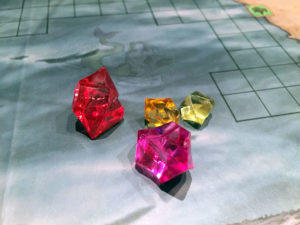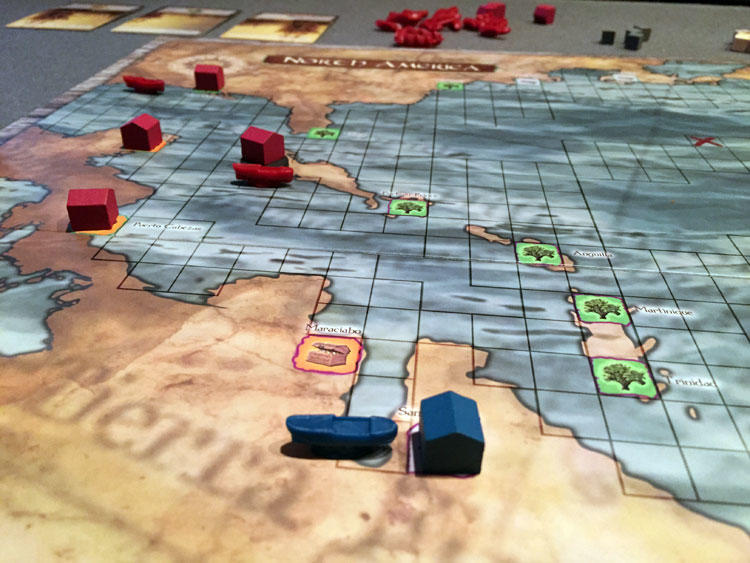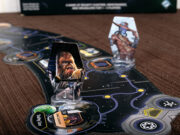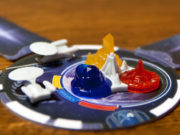 As someone who has always enjoyed spending his summers doing a bit of sailing on Lake Michigan, I’ve naturally been drawn to games with a nautical theme. This goes doubly for games set during the “age of sail”, when those massive wooden sailing ships ruled the oceans.
As someone who has always enjoyed spending his summers doing a bit of sailing on Lake Michigan, I’ve naturally been drawn to games with a nautical theme. This goes doubly for games set during the “age of sail”, when those massive wooden sailing ships ruled the oceans.
Recently, a new game called Empires at Sea made its way to our gaming table. Originally funded on Kickstarter from 448 backers, Empires at Sea is the first game (and self-published) from Zach and Amy Silverzweig. Empires at Sea bills itself as a game of trade, exploration, war and pirates. While we love all of those things, the real question is, does it deliver on fun? Time to find out!
Empires at Sea is a nautical based exploration and expansion game for 2-5 players that takes about 60-90 minutes to play (or longer with the higher player counts).
Game Overview:
In Empires at Sea, each player takes on the role of one of five different nations (Britain, France, USA, Spain and the Dutch) looking to expand their nautical empire. The game is played over 15 rounds, during which players will be capturing ports, trading for resources, playing captain cards and attacking other ships and ports. At the end of the game, players earn victory points for ports, resources and ships they control (or have captured). The player with the most points is the winner.
Game Components:

The game components in Empires at Sea are a bit of a mixed bag. Some things were done really well, others not so much. Let’s start with the good. The game comes with a large, doubled sided game board that has a really well done illustration of either the Americas or the Americas, Africa and Europe. (The map showing just the Americas is only used in a two player game.) The board is overlayed by a grid, which helps determine movement.
Each player gets 10 wooden port cubes, 5 Transports, 4 Frigates and 2 Ships of the Line. The ships are nice looking miniatures that are fun to sail around the map. Also included are four decks of cards (Captain, Weather, History and Port). These all have thematic artwork on them that looks like old paintings. I’m not sure if the artwork is from actual paintings or fresh for the game, but in either case, they fit the theme very well.
The game also comes with a number of wooden cubes in brown and grey to represent wood and steel. Long time readers know my feelings on using wooden cubes in games. They are serviceable, if a bit lackluster. To represent the gold resource, little plastic gem tokens are used. What’s odd is that the single gold prices are in two different shades of yellow, while the larger gold pieces are gem tokens made up of various different colors. I’m not sure why this is the case, as it confused us quite a bit. It would have been nice for all the gold to be the same shade of yellow.
The rulebook that comes with the game also needs a bit of help. There are many confusing sections that required me to jump online to try to figure out, especially with the combat section. The saving grace is that the publisher seems to be aware of this and has been actively updating the rulebook. The PDF on their website says version 8. I’m not sure which book comes in the box, but players should definitely get the updated PDF before diving in.
How to Play:
As mentioned earlier, Empires at Sea is played over the course of 15 rounds, each of which is divided into a few parts.
Each player chooses a nation and starts with a random port on the game board. Once everyone has their pieces and the various decks are shuffled, you are ready to begin.

Each round is played out in the following steps:
1. Weather: Draw a weather card and apply its effects. Weather cards will either boost or hinder movement during the round.
2. History: Draw a history card. These will alter the game in various ways, usually effecting specific nations.
3. Production: Players collect resources based on ports they control and industry cards they have played.
4. Player Actions: Each player takes their turn in a clockwise manner starting with the start player. On a players turn, they must play one of their captain cards. If they cannot, or do not want to, they discard one for 3 gold.
After they play their card, a player can take up to 5 actions. Different actions include:
Sailing: Move one of your ships in any direction (wind permitting) as far as you want, until you hit a border of some kind. Diagonal movement is not allowed.
Trading: If you are adjacent to a port, trade any resource you have for one the port produces.
Buy a port: Spend one wood, steel, and gold and take control of an uncontrolled port you are adjacent to.
Attack: Attack an adjacent ship or port.
Combat is handled via a die roll, usually with modifiers. Each ship type and port (which can be upgraded to a fort or naval base) has a defense value. You have to roll higher (after modifiers) on a six-sided die than the defense value. If you do, you sink the ship (take it into your score pile) or capture the port. Attacked ships may also counter-attack.
5. Bribe the Pirate: After all players have taken their turn, players my bribe the pirate. Each player secretly selects an amount of gold to bribe with. The player that offers the most gold can control the pirate for the round. He gets five actions to use to pester the other players. If there is a tie for bribed gold, the pirate does nothing that round.
6. Draw Cards: Players refill their hands to 6 cards and the start player passes to the left.
Rounds continue in this manner until all 15 rounds have been played. At this point, players total up their victory points from ships, ports, and resources. The player with the most points is declared the High Admiral.

Game Experience:
When I first saw the images of Empires at Sea, I had high hopes for the game play. The gridded map of the oceans looked intriguing, along with the cool little ship miniatures. Unfortunately, after putting this one through the paces, I don’t think it’s going to be making its way to our gaming table again.
My first thought after playing was that Empires at Sea could have used a lot more playtesting. There were quite a few things that came up during the game that just didn’t feel very well thought out.
The first were the weather cards. If I had a suggestion for a house rule to make Empires at Sea better, it’d be to take the weather deck and throw it in the trash. While some of the weather cards are good, boosting ship movement, many are also bad. As they are all mixed into a single deck, it will be completely random when you get a bad card or good. The problem is that bad cards can be REALLY bad. Many limit movement, such as preventing any ship from sailing North and West for a round. As the game board is made up of a grid with lots of gaps, this can be particularly punishing, especially early in the game when you have only have one ship.

In fact, in one of our games, I literally couldn’t move my ship for two rounds due to weather and history cards. There are captain cards that can help alleviate the weather, but those are few and far between. Sitting at a port doing nothing for two rounds not only puts you way behind the other players, but is also incredibly boring. Instead of blocking movement for half of the board, a more forgiving weather card would just force extra actions to move against the wind.
Moving on, the resources also don’t seem very balanced. There are three main resources, gold, wood, and steel. Wood and steel appear to be far more valuable than gold. Most cards take multiple wood and steel, yet far less also require gold. Gold seems to be mostly used for bribing the pirate, something we rarely did in our game (at least early on). The problem is that your starting port is random, so if you draw a gold port to start, you are going to be struggling to keep up with the other players.
We had a situation arise where a player couldn’t even get a 3rd port until 7 rounds in. From a combination of not having enough steel, and the weather cards preventing him from sailing to any port that offered steel, he was so far behind the other players by the time he got his third port, he was basically out of the game.

I think the game just has too much randomness thrown in from the deck draws. It makes the game REALLY swingy. The history cards will randomly punish (or benefit) one partially nation. Some will steal resources, stop movement, or provide random bonuses. Even the captain cards fall prey to this. There is one particular card that costs 2 of each resource, but it doubles the trade output from that point further. This is an incredibly powerful card (of which there is only one of in the game). If a player spends one turn using all 5 of their actions to trade, they can really outpace the other players.
Now I don’t want you to think Empires at Sea is all bad. The game does have some good ideas. Many of the captain’s cards work really well in the game and help you get around some limitations. I enjoyed the variety I saw in those. The history cards were also a neat idea, just their implementation was too random.
Once I was able to figure out combat, I actually thought it was a good mechanic for the game. Buying ports, upgrading them to forts and bases was pretty fun. The game definitely has a bit of an engine building feel to it. After a while, everyone seemed to have set up their empires and production lines. At this point there will be multiple frigates on the board ready to show their might. This part of the game can fun, especially if you like combat.
Final Thoughts:

I think Empires at Sea had some good ideas, but many of them are outweighed by the random and punishing nature of its card decks. This, combined with the fact that the player actions can start to feel a bit repetitive, means that Empires at Sea is probably not going to be making its way to your gaming table very often.
Right now the play time runs at 1-2 hours, which feels way to long for what the game is. There is just not enough meat here to justify that long of a play. I think a 45 minute play time would probably have been better.
I was a bit bummed with our experience with Empires at Sea. I loved the theme and liked the idea of the history cards. However, the execution of the game’s cards, especially the weather deck really broke the enjoyment of the game for us. I feel like Empires at Sea could have used a bit more playtesting. While the game does have a few aspects that are enjoyable, overall negatives outweigh the positives.
If you’d like to try out Empires of the Sea for yourself, you can pick it up for about $40.
Final Score: 1.5 Stars – Some good ideas can’t save a game that doesn’t feel thoroughly playtested. The randomness of the decks caused too many crippling issues.
 Hits:
Hits:
• The combat mechanic was a good implementation
• I liked the idea of the History cards
• Game board artwork is great
Misses:
• Weather deck is punishing
• Too much randomness from card draws
• Game plays too long for what it is
• Resources don’t feel balanced
























We have the opposite experience where gold is concerned. Because wood and steel are 5 units/point, but gold is 2/point, people often race to take control over the ports that produce gold.
We did notice the potential swinginess of the game, but it was much less prevalent for us with a higher player count. I’d never play this game with just 2 players without getting rid of some of the history cards though.
Thanks for the comment Travis. I’m glad to see that the swinginess was less crippling at the higher player counts for you. I really wanted to like this one because I loved the theme, but it just fell apart for us.
I can understand that. After my first 2 player game I was very turned off and frustrated with the game.
Thankfully, that trend didn’t continue, and I’ve had fun with it each time I’ve played since. One person in my group actually prefers this to Merchants and Marauders (which is crazy if you ask me, but everyone is entitled to their opinion) now.
We also tweaked a few things such as house ruling that the 2 for 1 trade card can only be used 1x per port per round.
Some house rules could definitely help make this one more playable. We found that trade card to also be really powerful. I’d also adjust the weather deck to not stop people from acting on their turn. This one just needs too many adjustments for it to be fun for us.
I had similar feelings when playing it earlier this year. The premise sounded great. But we killed the pirate ship in the 2nd round and it never reappears. So that whole aspect of the game was a mute.
We also found the weather to be killer. Being a couple spaces away from a port doesn’t mean you’ll actually get there to do anything on your turn – because the weather can kill movement East so you can’t get there. Some games may take a couple hours and I never feel the time going by because there’s plenty of action and strategizing the whole time. Unfortunately, this was the opposite.
Thank you for the link to the new rulebook! I was using the one that came with the game and had to guess at several rules! The game did not seem too hard and hopefully the updated rules fix some of the issues, particularly how devastating weather can be.
The updated rulebook is definitely more helpful. I had a hard time figuring out what each component was in the included rulebook because there were no pictures. But thankfully the updated rulebook has them.
My husband and I have been playing this game over the last few days and we love it! We enjoy the weather and history cards immensely and the vast differences it gives each game. They may be crippling now and then, but it brings much more challenge and strategy to every round.
Thanks for the comment Athena, I’m glad you are having fun with the game.
You sir are a fool, this game is tons of fun! If the weather and history cards are too challenging for you, maybe you should go back to snakes and ladders!
Thanks for the comment. I stand by my thoughts on the weather and history cards though. Forcing people to skip entire turns based on the random pull of a card doesn’t feel like good game design to me. I’m glad you are having fun with the game though.
Yah, and when you land on a snake you go all the way back to the beginning! Oh noes!
Tony, thanks for putting this review together.
This was a game I was on the fence with when the campaign ran and thought about backing it as it looked like a more strategic version of Dredd Pirate:(https://boardgamegeek.com/boardgame/5457/dread-pirate)
Which is a wonderful simple pirate game (all be it a bit long for what it is- and also has a surprisingly horrible rule book =p)
Then through game acquisition negotiations with my wife and dwindling shelf space we passed on it. Your review for me confirmed it was a good call. I am not a fan of games where players get stuck for a few rounds- that takes alot of fun out of the sails for me.
Thanks-